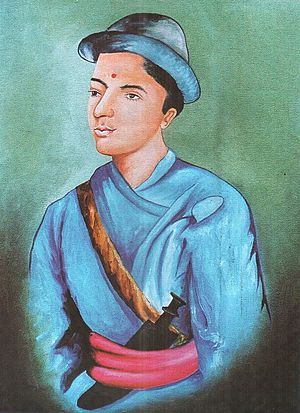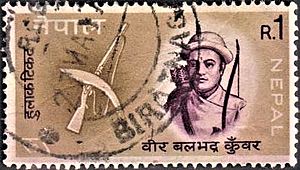Balbhadra Kunwar facts for kids
Quick facts for kids
Shree Captain Later General
Balbhadra Kunwar
|
|
|---|---|
| श्री कप्तान पछि जेनरल बलभद्र कुँवर |
|

Young Balbhadra Kunwar around Anglo-Nepal war
|
|
| Personal details | |
| Born | 30 January 1789 Bhanwarkot, Kavre, Gorkha Empire (present-day Bhanwarkot, Panchkhal Kavrepalanchok District, Nepal) |
| Died | 13 March 1823 (aged 34) Nowshera, Sikh Empire (present-day Nowshera, Khyber Pakhtunkhwa, Pakistan) |
| Parents |
|
| Relatives | see Kunwar family see Family of Amar Singh Thapa see Rana dynasty |
| Awards | National heroes of Nepal (posthumous) |
| Military service | |
| Allegiance | |
| Rank | Captain (Nepali convention) |
| Battles/wars | Anglo-Nepalese War |
Balbhadra Kunwar Chhetri (born January 30, 1789 – died March 13, 1823) was a brave military leader from the Kingdom of Nepal. He is remembered as one of the National heroes of Nepal. People greatly admired his skills in defending the Nalapani fort during the Anglo-Nepalese War (1814–1816). As a Captain in the Nepali army, he was in charge of protecting the forts around Dehradun.
Contents
What's in a Name?
Balbhadra's first name, Balabhadra, comes from Baladeva, who was the older brother of Krishna in ancient stories. His name is a mix of two words: Bala, meaning strength, and Bhadra, meaning lucky or good.
His Family and Early Life
Balbhadra Kunwar was born in Bhanwarkot, which is now part of Panchkhal in Kavrepalanchowk District. His father was Chandrabir Kunwar. His mother, Ambika Devi, was the sister of a Kaji (a high-ranking official) named Ranajor Thapa. She was also the daughter of a very important Kaji, Amar Singh Thapa.
Balbhadra's brother, Birabhadra Kunwar, was also a military leader. He served in areas like Kumaun and Kangra. He was also a governor in Garhwal.
The Anglo-Nepal War (1814–1816)
As a commander of the Gorkhali forces, Captain Balbhadra Kunwar was given the important job of defending the Dehradun area. The Nepali kingdom had been growing its borders, which eventually led to a big fight with the British East India Company. This conflict started the Anglo-Nepalese War.
Balbhadra knew he couldn't defend the town of Dehradun itself. So, he moved his small army of 600 people, including women and children, to the strong hill fort of Khalanga. They faced a much larger British force of 3,000 to 3,500 soldiers. The British even offered to make him a governor if he surrendered, but he refused.
The Battle of Nalapani
In October 1814, a British general named Sir Rollo Gillespie arrived with 3,500 troops and many cannons. They wanted to take over Nepali lands between the Ganges and Yamuna rivers. Captain Balbhadra Kunwar had set up his defense at Nalapani, a hill north-east of Dehradun.
The first battle happened on October 24, 1814. The British tried to attack but failed and had to go back to Dehradun. Another battle took place on October 31, 1814. In this fight, General Gillespie, the British commander, and another officer named Colonel Alice were killed.
The British kept the fort under siege for a month. When they couldn't win by fighting, they cut off the fort's water supply. This was a very tough challenge for the Nepali army. They were fighting a much larger, well-trained army from one of the world's biggest empires. Balbhadra asked for more soldiers from Kathmandu, but the capital couldn't send any. The Nepali army was always outnumbered.
Even without water, the Nepali soldiers were determined to keep fighting. British cannonballs broke through the fort walls, causing many deaths and injuries. Still, the remaining soldiers refused to give up. At one point, they bravely walked out of the fort in a line to drink water from the river. The British soldiers watched in surprise as the Nepalis quenched their thirst and returned to the fort.
On November 30, 1814, after four days without water and many losses, Captain Balbhadra Kunwar and about 70 survivors had to leave the fort. They didn't surrender. Balbhadra came out with his kukri (a traditional Nepali knife) in hand and shouted to the British, "You could never have won this battle! I am leaving this fort on my own. There is nothing left inside but the bodies of children and women!" He and his remaining troops then escaped into the hills.
Later, a peace agreement called the Sugauli Treaty was signed on December 2, 1815, between the King of Nepal and the British East India Company.
Serving Maharaja Ranjit Singh
Balbhadra Kunwar survived the Anglo-Nepalese War. After the war, he traveled to Lahore, the capital of Punjab. Many Nepalis had gone there to join new army groups formed by Maharaja Ranjit Singh, the ruler of Punjab. Captain Balbhadra Kunwar was made a General and commander of these new "Goorkha" regiments, which were made up entirely of Nepali soldiers.
His Final Battle and Legacy
In 1822, during a war between the Sikhs and Afghans, the Nepali soldiers in the Sikh army fought very bravely. Balbhadra Kunwar was killed by Afghan cannons in Naushera, near Peshawar. He was serving under the famous General Hari Singh Nalwa, who honored him for his courage in battle.
After the Anglo-Nepali War, the British East India Company built a special memorial at Nalapani. This memorial honored the Gorkhali soldiers and Captain Balbhadra Kunwar for their incredible bravery.



